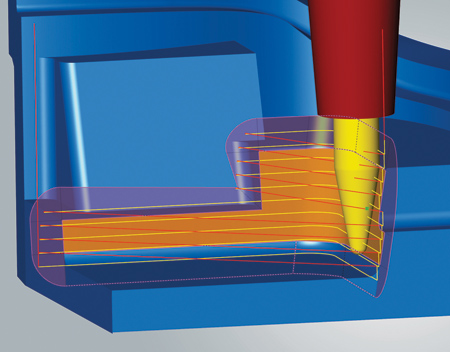
3D Z-Level Shape Finishing

3D Optimized Roughing
OPEN MIND Technologies AG has introduced hyperMILL 2018.2, the latest version of its advanced, comprehensive CAM software. hyperMILL 2018.2 offers a range of enhancements and new features for 3D Shape Z-level Finishing and 3D Optimized Roughing, greater CAD functionality and more.
For reduced programming times and improved milling, 3D Z-level Shape Finishing, available in hyperCAD-S, has two new features. "Automatic face extension" can be used during CAM programming to automatically extend the selected milling surfaces, eliminating manual CAD work and resulting in cleaner corner cuts. Also, 3D Z-level Shape Finishing now has the ability to support conical barrel cutters in addition to general and tangential cutters.
During 3D Optimized Roughing, multiple allowances are now recognized and accounted for when using free tool geometries, resulting in easier programming and a high level of flexibility for defining special tools. hyperMILL 2018.2 can define different allowances and adapt the machining process accordingly. High-feed cutters have a special cutting geometry that is easy to define using tool management, and hyperMILL 2018.2 uses the free geometries of the cutting tool edge for calculation, simulation and collision checking.
"Keeping the hyperMILL suite at the forefront of CAM technology, we are pleased to offer our customers improved CAM strategies and enhanced CAD tools for even greater machining productivity through our new release of hyperMILL 2018.2," said Alan Levine, Managing Director of OPEN MIND Technologies USA, Inc.
New hyperMILL 2018.2 functionality also includes several enhancements to its hyperCAD-S module, including the ability to measure and record the distances between two shapes such as face models, solids, meshes or stock. In addition, for easy changes to milling boundaries and turning contours, hyperMILL 2018.2 offers a "V sketch" command that assigns geometric constraints to 2-D contours. When individual contours are changed, the sketch is automatically updated using their dependencies.
The electrode module, which provides quick designing of die-sinking electrodes, offers a new Virtual Electrode function for securely creating electrode copies which are checked for collisions, and can be assigned new technology values or the values of the master electrodes. For easier analysis, the reference system and eroding position for each electrode copy are included in a report.
For more information contact:
OPEN MIND Technologies USA, Inc.
1492 Highland Ave., Unit 3
Needham, MA 02492
888-516-1232
info.americas@openmind-tech.com
www.openmind-tech.com